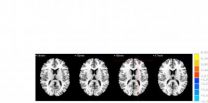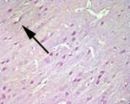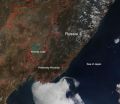(Press-News.org) A new computer program could help doctors predict which patients might suffer potentially fatal side-effects from a key stroke treatment.
The program, which assesses brain scans using pattern recognition software similar to that used in airport security and passport control, has been developed by researchers at Imperial College London. Results of a pilot study funded by the Wellcome Trust, which used the software are published in the journal Neuroimage Clinical.
Stroke affects over 15 million people each year worldwide. Ischemic strokes are the most common and these occur when small clots interrupt the blood supply to the brain. The most effective treatment is called intravenous thrombolysis, which injects a chemical into the blood vessels to break up or 'bust' the clots, allowing blood to flow again.
However, because intravenous thombolysis effectively thins the blood, it can cause harmful side effects in about six per cent of patients, who suffer bleeding within the skull. This often worsens the disability and can cause death.
Clinicians attempt to identify patients most at risk of bleeding on the basis of several signs assessed from brain scans. However, these signs can often be very subtle and human judgements about their presence and severity tend to lack accuracy and reliability.
In the new study, researchers trained a computer program to recognise patterns in the brain scans that represent signs such as brain-thinning or diffuse small-vessel narrowing, in order to predict the likelihood of bleeding. They then pitted the automated pattern recognition software against radiologists' ratings of the scans. The computer program predicted the occurrence of bleeding with 74 per cent accuracy compared to 63 per cent for the standard prognostic approach.
Dr Paul Bentley from the Department of Medicine, lead author of the study, said: "For each patient that doctors see, they have to weigh up whether the benefits of a treatment will outweigh the risks of side effects. Intravenous thrombolysis carries the risk of very severe side effects for a small proportion of patients, so having the best possible information on which to base our decisions is vital. Our new study is a pilot but it suggests that ultimately doctors might be able to use our pattern recognition software, alongside existing methods, in order to make more accurate assessments about who is most at risk and treat them accordingly. We are now planning to carry out a much larger study to more fully assess its potential."
The research team conducted a retrospective analysis of computerized tomography (CT) scans from 116 patients. These are scans that use x-rays to produce 'virtual slices' of the brain. All the patients had suffered ischemic strokes and undergone intravenous thrombolysis in Charing Cross Hospital. In the sample the researchers included scans from 16 patients who had subsequently developed serious bleeding within the brain.
Without knowing the outcomes of the treatment, three independent experts examined the scans and used standard prognostic tools to predict whether patients would develop bleeding after treatment.
In parallel the computer program directly assessed and classified the patterns of the brain scans to produce its own predictions.
Researchers evaluated the performance of both approaches by comparing their predictions of bleeding with the actual experiences of the patients.
Using a statistical test the research showed the computer program predicted the occurrence of bleeding with 74 per cent accuracy compared to 63 per cent for the standard prognostic approach.
The researchers also gave the computer a series of 'identity parades' by asking the software to choose which patient out of ten scans went on to suffer bleeding. The computer correctly identified the patient 56 per cent of the time while the standard approach was correct 31 per cent of the time.
The researchers are keen to explore whether their software could also be used to identify stroke patients who might be helped by intravenous thrombolysis who are not currently offered this treatment. At present only about 20 per cent of patients with strokes are treated using intravenous thrombolysis, as doctors usually exclude those with particularly severe strokes or patients who have suffered the stroke more than four and half hours before arriving at hospital. The researchers believe that their software has the potential to help doctors to identify which of those patients are at low risk of suffering side effects and hence might benefit from treatment.
INFORMATION: The study was supported through the Wellcome Trust Institutional Strategic Support Fund and the researchers have secured further funding from the Trust to conduct a larger study that will be looking at data from about 2000 more subjects across London.
For more information please contact:
Francesca Davenport
Research Media Officer
Imperial College London
Email: f.davenport@imperial.ac.uk
Tel: +44(0)20 7594 2198
Out of hours duty press officer: +44(0)7803 886 248
Notes to editors:
1. Reference Bentley et al. "Prediction of stroke thrombolysis outcome using CT brain machine learning." Neuroimage Clinical. 2014. Doi: 10.1016/j.nicl.2014.02.003. Available at: http://www.sciencedirect.com/science/article/pii/S2213158214000217#
2. About Imperial College, London
Consistently rated amongst the world's best universities, Imperial College London is a science-based institution with a reputation for excellence in teaching and research that attracts 14,000 students and 6,000 staff of the highest international quality. Innovative research at the College explores the interface between science, medicine, engineering and business, delivering practical solutions that improve quality of life and the environment - underpinned by a dynamic enterprise culture.
Since its foundation in 1907, Imperial's contributions to society have included the discovery of penicillin, the development of holography and the foundations of fibre optics. This commitment to the application of research for the benefit of all continues today, with current focuses including interdisciplinary collaborations to improve global health, tackle climate change, develop sustainable sources of energy and address security challenges.
In 2007, Imperial College London and Imperial College Healthcare NHS Trust formed the UK's first Academic Health Science Centre. This unique partnership aims to improve the quality of life of patients and populations by taking new discoveries and translating them into new therapies as quickly as possible.
Website: http://www.imperial.ac.uk
3. About the Wellcome Trust
The Wellcome Trust is a global charitable foundation dedicated to achieving extraordinary improvements in human and animal health. It supports the brightest minds in biomedical research and the medical humanities. The Trust's breadth of support includes public engagement, education and the application of research to improve health. It is independent of both political and commercial interests.http://www.wellcome.ac.uk
Airport security-style technology could help doctors decide on stroke treatment
2014-04-23
ELSE PRESS RELEASES FROM THIS DATE:
Gym culture likened to McDonald's
2014-04-23
Visit a typical gym and you will encounter a highly standardised notion of what the human body should look like and how much it should weigh. This strictly controlled body ideal is spread across the world by large actors in the fitness industry.
A new study explores how the fitness industry in many ways resembles that of fast food. One of the authors is from the University of Gothenburg.
McDonaldisation of the gym culture is the theme of an article published in Sports, Education and Society, where Thomas Johansson, professor at the University of Gothenburg, together ...
Acupuncture at Waiguan improves activation of functional brain areas of stroke patients
2014-04-23
Both acupuncture at Waiguan (SJ5) and sham acupuncture can activate/deactivate several brain regions in patients with ischemic stroke, but there are some difference in Brodmann areas 4, 6, 8, Brodmann areas 7, 39, 40, Brodmann areas 18, 19, 22 and Brodmann areas 13, 24, 32, 28. Most studies addressing the specificity of meridians and acupuncture points have focused mainly on the different neural effects of acupuncture at different points in healthy individuals. Dr. Ji Qi and co-workers from School of Traditional Chinese Medicine, Southern Medical University in China examined ...
Physicist demonstrates dictionary definition was dodgy
2014-04-23
It is the defining moment that demonstrates a QUT physicist was correct in pointing out a 99-year-old mistake to one of the world's most authoritative dictionaries.
QUT Senior Lecturer in Physics, Dr Stephen Hughes, sparked controversy over how a humble siphon worked when he noticed an incorrect definition in the prestigious Oxford English Dictionary.
In 2010, eagle-eyed Dr Hughes spotted the mistake, which went unnoticed for 99 years, which incorrectly described atmospheric pressure, rather than gravity, as the operating force in a siphon.
Dr Hughes demonstrated ...
Atorvastatin protects against cerebral ischemia/reperfusion injury
2014-04-23
In addition to its lipid-lowering effect, statins exert anti-inflammatory and antioxidant effects as well. Statins also provide protection against renal, pulmonary and myocardial ischemia/reperfusion injury. However, little evidence is available on similar changes in cerebral ischemia/reperfusion injury. Therefore, Dr. Qiuyun Tu and colleagues from Third Xiangya Hospital of Central South University in China verified that atorvastatin, a commonly used lipid-lowering drug, protects against cerebral ischemia/reperfusion injury through anti-infammatory and antioxidant effects. ...
Is nuclear power the only way to avoid geoengineering?
2014-04-23
Los Angeles, London (April 23, 2014). "I think one can argue that if we were to follow a strong nuclear energy pathway—as well as doing everything else that we can—then we can solve the climate problem without doing geoengineering." So says Tom Wigley, one of the world's foremost climate researchers, in the current issue of Bulletin of the Atomic Scientists, published by SAGE. Refusing to take significant action on climate change now makes it more likely that geoengineering will eventually be needed to address the problem, Wigley explains in an exclusive Bulletin interview. ...
Midlife occupational and leisure-time physical activity limits mobility in old age
2014-04-23
Inverse Effects of Midlife Occupational and Leisure Time Physical Activity on Mobility Limitation in Old Age
Strenuous occupational physical activity in midlife increases the risk of mobility limitation in old age, whereas leisure-time physical activity decreases the risk. This is found in a study which followed up 5,200 public sector employees for 28 years. The study was conducted at the Gerontology Research Center in Finland and the Finnish Institute of Occupational Health.
Heavy physical labor is often repetitive, wears the body and lasts for several hours a day. ...
Fires in the Primorsky Province of Russia
2014-04-23
One of the most influential ecological disturbances is fire. Fire can spread so rapidly and for such far distances that its impact on land is for the most part far greater than any other factor. Less than optimal logging practices in the Primorksy region worsen the problems of human-caused fires in this area. Abandoned fields with dry grasses provide the detritus that can fuel an out of control blaze with a single spark.
In southwest Primorsky Province dry grass has been burned for centuries. This uncontrolled method of managing agricultural areas each year turns the ...
New discovery helps solve mystery source of African lava
2014-04-23
EAST LANSING, Mich. — Floods of molten lava may sound like the stuff of apocalyptic theorists, but history is littered with evidence of such past events where vast lava outpourings originating deep in the Earth accompany the breakup of continents.
New research at Michigan State University shows that the source of some of these epic outpourings, however, may not be as deep as once thought. The results, published in the Journal Geology, show that some of these lavas originated near the surface rather than deep within the mantle.
When geoscientists want to learn more about ...
Non-uniform genetic mutations identified in lung cancers could lead to targeted treatment
2014-04-23
The research, published in the journal Oncotarget, explored tumour heterogeneity – where different cells have different appearances or their own DNA signatures within the same cancer. Such differences could make it difficult to design effective, targeted treatment strategies.
Firstly they confirmed the mutual exclusivity between the EGFR mutation and either the KRAS or BRAF mutation. Secondly, they found that lung cancers driven by the EGFR gene mutation have that specific mutation present uniformly throughout the tumour, regardless of microscopic appearance. In stark ...
ADHD drug may help preserve our self-control resources
2014-04-23
Methylphenidate, also known as Ritalin, may prevent the depletion of self-control, according to research published in Psychological Science, a journal of the Association for Psychological Science.
Self-control can be difficult — sticking with a diet or trying to focus attention on a boring textbook are hard things to do. Considerable research suggests one potential explanation for this difficulty: Exerting self-control for a long period seems to "deplete" our ability to exert self-control effectively on subsequent tasks.
"It is as if self-control is a limited resource ...




